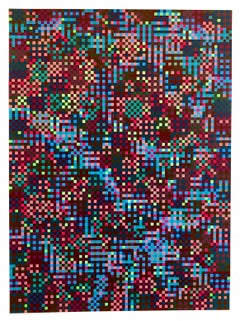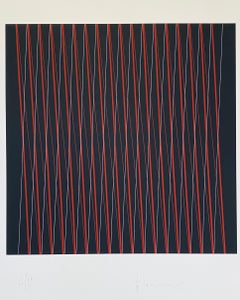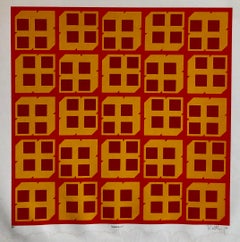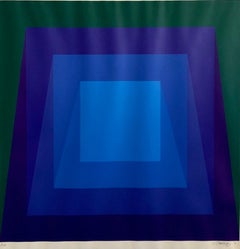Items Similar to Op Art, Kinetic 1970s Original Vintage Silkscreen Lithograph Print
Want more images or videos?
Request additional images or videos from the seller
1 of 5
David RothOp Art, Kinetic 1970s Original Vintage Silkscreen Lithograph Print1977
1977
$750
£560.21
€649.48
CA$1,041.36
A$1,167.23
CHF 607.74
MX$14,252.33
NOK 7,716.10
SEK 7,314.17
DKK 4,845.82
Shipping
Retrieving quote...The 1stDibs Promise:
Authenticity Guarantee,
Money-Back Guarantee,
24-Hour Cancellation
About the Item
Hand signed and numbered limited edition print.
David Roth studied at the Illinois Institute of Technology's Institute of Design and was twice the recipient of the Moholy-Nagy Scholarship in visual design. It was Roth's initial work as a designer at fine art for commercial use that brought him interesting positions as art director for Lanvin, Charles at the Ritz, and Germain Monteil.
. The strings are tied in bunches and closely hung tram a wooden bar. The size and shape of the string is similar to that at a canvas painting. Each bundle is represented by a vertical row at squares on the graph and the groupings at string are lined up along the wall according to the horizontal rows at the program. The six primary and secondary colors are used in their full intensity along with black, grey, and white.
As a painter Roth works to formulate with color. Some painters regard color as a concomitant of form, hence a subordinate, but Roth's color is the chief medium of his pictorial language. A programmed juxtaposition at primary color allows Roth and the viewer to play upon various combinations. The graphs Roth executes are proportioned according to a strict mathematical formula - the pictures are
Composed according to horizontal and vertical divisions on the graph paper. The optical quality of color, deliberately sought, has its roots in the Bauhaus investigations of illusion, and thus has a direct relationship to the Op art produced in postwar Europe. Roth has arranged his hues so as to persuade the planes to separate from the ground on which they are planted, and float free in space. It is almost as if Roth is giving us a "readout" on his creative process. Although the graphs appear to vary in their use of color the same colors are used throughout, also the same amount of color. Roth's work illustrates the sophistication of the human eye-brain relationship that has developed and invites the viewer to participate in the evolution at visionary ideas.
One Man Shows
1966 The Gallery Upstairs, Buffalo, New York
1967 The Gallery Upstairs, Buffalo, New York
1969 The House of Graphics, New York
1969 Illinois Institute of Technology, Chicago, Illinois
1972 Robert Elkon Gallery, New York
1973 Robert Elkon Gallery, New York
1974 Robert Elkon Gallery, New York
1975 Michael Wyman Gallery, Chicago
1975 Robert Elkon Gallery, New York
1976 G.W. Einstein, New York
1976 Robert Elkon Gallery, New York
1977 Robert Elkon Gallery, New York
1977 G.W. Einstein, New York
1978 Sunne Savage Gallery, Boston, Massachusetts
1978 Robert Elkon Gallery, New York
1979 Nancy Roth Gallery, Katonah, New York
Group Exhibitions
1967 State University of New York, Buffalo
1970 Ronald Feldman Gallery
1970 The Everyman Gallery
1971 Robert Elkon Gallery, New York
1972 The Brooklyn Museum, New York
1972 The Newark Museum, New Jersey
1972 Art Institute of Chicago, Illinois
1973 Contemporary Arts Center, Cincinnati, Ohio
1973 Museum at Art, Rhode Island School of Design
1973 Robert Elkon Gallery, New York
1974 Indianapolis Museum of Art, Indiana
1974 Taft Museum, Cincinnati, Ohio
1974 Michael Wyman Gallery, Chicago, Illinois
1974 Cleveland Museum of Art, Ohio
1975 Van Stratten Gallery, Chicago, Illinois
1975 Robert Elkon Gallery, New York
1975 New York Cultural Center
1976 Robert Elkon Gallery, New York
1976 Indianapolis Museum of Art,
1978 Sunne Savage Gallery, Boston, Massachusetts
1978 Dorothy Rosenthal Gallery, Chicago, Illinois
1978 Nancy Roth Gallery, Katonah, New York
1978 Robert Elkon Gallery, New York
Private Collections
Mr. Richard Brown Baker
Mrs. J. Fredik Byers Ill
Mr. & Mrs. Martin Goodman
Senator and Mrs. Jacob Javits
Mr. Werner Kremarsky
Mrs. Vera List
Mrs. Dorothy Miller
Mr. Richard Miller
Mr. Stanley Mortimer
Mr. S.I. Newhouse Jr.
Mr. Samuel Sachs
Public and Corporate Collections
The Albright-Knox
Amstar Corporation
American Telephone and Telegraph
Ball State University Museum
Philadelphia Museum of Art
Chase Manhattan Collection
Museum at Contemporary Arts, Teheran,
Iran (Gift from Nelson Rockefeller)
Hess Oil Corporation
Lehman Brothers
First National City Bank
Rockefeller University
Owens-Corning Fiberglass
Swiss Investment Bank
United Mutual Savings & Loan
Newark Museum at Art
- Creator:David Roth (1942, American)
- Creation Year:1977
- Dimensions:Height: 29.5 in (74.93 cm)Width: 32.75 in (83.19 cm)
- Medium:
- Movement & Style:
- Period:
- Condition:minor wear.
- Gallery Location:Surfside, FL
- Reference Number:Seller: 32471stDibs: LU38212258382
David Roth
David Roth studied with Aaron Siskind and Harry Callahan at the Chicago Institute of Design in the early 1960s. He was represented by New York City's Robert Elkon Gallery in the 1970s, and his works are in numerous museums, such as the Philadelphia Museum of Art, the Brooklyn Museum and the Albright-Knox Art Museum, as well as in corporate and private collections.
About the Seller
4.9
Platinum Seller
Premium sellers with a 4.7+ rating and 24-hour response times
Established in 1995
1stDibs seller since 2014
1,777 sales on 1stDibs
Typical response time: <1 hour
- ShippingRetrieving quote...Shipping from: Surfside, FL
- Return Policy
Authenticity Guarantee
In the unlikely event there’s an issue with an item’s authenticity, contact us within 1 year for a full refund. DetailsMoney-Back Guarantee
If your item is not as described, is damaged in transit, or does not arrive, contact us within 7 days for a full refund. Details24-Hour Cancellation
You have a 24-hour grace period in which to reconsider your purchase, with no questions asked.Vetted Professional Sellers
Our world-class sellers must adhere to strict standards for service and quality, maintaining the integrity of our listings.Price-Match Guarantee
If you find that a seller listed the same item for a lower price elsewhere, we’ll match it.Trusted Global Delivery
Our best-in-class carrier network provides specialized shipping options worldwide, including custom delivery.More From This Seller
View AllPuerto Rican Abstract Geometric Op Art Silkscreen Lithograph Kinetic Art
By Tony Bechara
Located in Surfside, FL
Color Grid. Ziggurat form. Hand signed and numbered silkscreen.
Tony Bechara, Artist born in Puerto Rico in 1942. Painter, printmaker. Bechara attended Georgetown University in Washi...
Category
1970s Op Art Abstract Prints
Materials
Screen
Italian Kinetic Op Art Attilio Taverna Silkscreen Lithograph Print Light Artist
By Attilio Taverna
Located in Surfside, FL
*picture with description not included with lithograph.
Attilio Taverna, born 1945. Italian geometric abstract artist known for his painting and lithograph and silkscreen prints.
...
Category
1980s Abstract Prints
Materials
Lithograph
Abstract Geometric 1970s Kinetic Silkscreen Screen Print Manner Vasarely Op Art
By Paul M. Levy
Located in Surfside, FL
Paul Levy (American, b. 1944) An established designer and illustrator, Paul M. Levy was born in Brooklyn, New York, in 1944. He received his B.S. in Industrial Design from the Univer...
Category
1970s Abstract Geometric Abstract Prints
Materials
Screen
1970's Op Art Cintique Geometric Abstract Color Gradations Silkscreen Domberger
Located in Surfside, FL
Silkscreen serigraph Op art print.
Luitpold Domberger (1912-2005 ) was a pioneer of artistic screen printing in Germany.
Luitpold (Poldi) Domberger...
Category
1970s Op Art Abstract Prints
Materials
Screen
1960's Baladine Op Art KInetic Screenprint Lithograph Vibrant Mod Neon Colors
Located in Surfside, FL
This is hand signed in pencil. It is not numbered.
This appears to be a silkscreen or serigraph or a multi stone lithograph. It is a great hard edged, geometric, vibrant mid century...
Category
1960s Abstract Prints
Materials
Lithograph, Screen
Italian Kinetic Op Art Attilio Taverna Silkscreen Lithograph Print Light Artist
By Attilio Taverna
Located in Surfside, FL
*picture with description not included with lithograph.
Attilio Taverna, born 1945. Italian geometric abstract artist known for his painting and lithograph and silkscreen prints.
...
Category
1980s Abstract Prints
Materials
Lithograph
You May Also Like
David Roth, Abstract Screenprint, 1977
By David Roth
Located in Long Island City, NY
This screenprint was created by American artist David Roth. Roth's images are proportioned according to a strict mathematical formula - the pictures are composed according to horizon...
Category
1970s Op Art Abstract Prints
Materials
Screen
David Roth, Abstract Screenprint, 1979
By David Roth
Located in Long Island City, NY
This screenprint was created by American artist David Roth. Roth's images are proportioned according to a strict mathematical formula - the pictures are composed according to horizon...
Category
1970s Op Art Abstract Prints
Materials
Screen
David Roth, Abstract Screenprint, 1979
By David Roth
Located in Long Island City, NY
This screenprint was created by American artist David Roth. Roth's images are proportioned according to a strict mathematical formula - the pictures are composed according to horizon...
Category
1970s Op Art Abstract Prints
Materials
Screen
Untitled 9, Geometric Abstract OP Art Screenprint by David Roth
By David Roth
Located in Long Island City, NY
This screenprint was created by American artist David Roth. Roth's images are proportioned according to a strict mathematical formula - the pictures are composed according to horizon...
Category
1980s Op Art Abstract Prints
Materials
Screen
$680 Sale Price
20% Off
Untitled 25, Abstract Op Art Screenprint by David Roth
By David Roth
Located in Long Island City, NY
This screenprint was created by American artist David Roth. Roth's images are proportioned according to a strict mathematical formula - the pictures are composed according to horizon...
Category
1970s Op Art Abstract Prints
Materials
Screen
David Roth, Abstract Screenprint, 1979
By David Roth
Located in Long Island City, NY
This screenprint was created by American artist David Roth. Roth's images are proportioned according to a strict mathematical formula - the pictures are composed according to horizon...
Category
1970s Op Art Abstract Prints
Materials
Screen
More Ways To Browse
Op Art 1970s
String Art Vintage
Vintage Island Bar
Initials S J
Vintage Bar Chicago
Einstein Signed
Robert Indiana Silkscreen
Lanvin Work
Lanvin 1970
Rosenthal Squares
Fiberglass Ball
Vintage Telephones 1970s
Vintage 1970s Lanvin
J J Werner
Fiberglass Wall Art 1970
Dorothy Van Loan
Stanley Rosenthal
Calder Lithograph 1972



